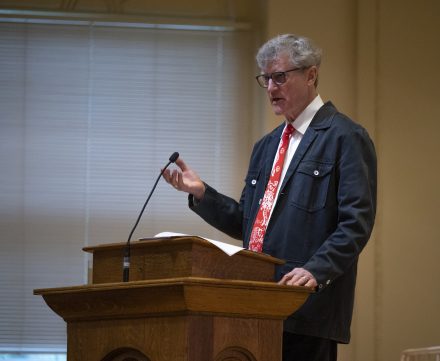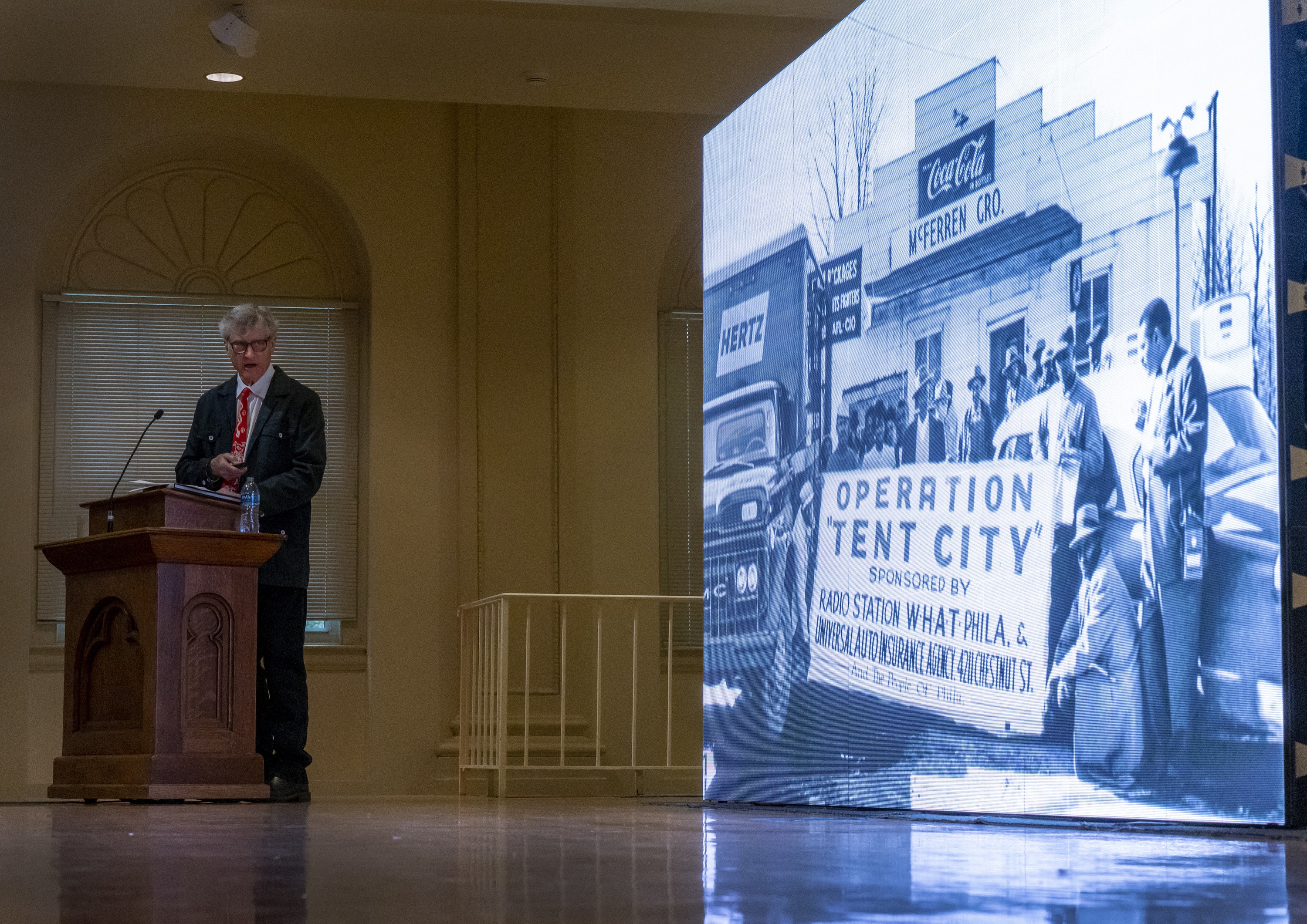Renowned historian and folklorist William Ferris spoke about the power and lasting legacy of photographs taken of the civil rights movement during the 1960s at the 2022 Elder Lecture in Whitley Auditorium on Thursday, April 14.
Since its birth as a new technology in the mid-19th century, photography has emerged as a powerful tool to both document history and inspire action for the future.
Look no further than the powerful images of the civil rights movement in the American South from 1960 to 1970, as a range of photographers captured the stoic strength of protestors, the snarling faces of Ku Klux Klan members and the violence that activists worked through to push the cause of human rights forward. These were the images flashing across the screen Thursday night next to renowned historian and folklorist William Ferris as he delivered the 2022 James P. Elder Lecture to the crowd gathered in Whitley Auditorium.

“These images pull back the veil of invisibility and reveal the humanity of Black women, men and children who voted, marched and sang freedom songs to affirm their full citizenship as Americans,” Ferris said during the lecture. “These photographs are an inspiration to us today and to future generations as we continue the fight for justice for all humankind.”
The Joel R. Williamson Eminent Professor of History Emeritus at the University of North Carolina at Chapel Hill and the former chairman of the National Endowment for the Humanities, Ferris’s remarks built upon his book, “I AM A MAN: Photographs of the Civil Rights Movement, 1960-1970.” The book itself was inspired by a traveling exhibit of the same name curated by Ferris that drew record crowds in France before moving to the United States.
His life as a folklorist has been focused on stories, and Ferris shared Thursday that increasingly he has focused on photography as key to those stories. As director for the Study of the American South at the University of Mississippi, he co-edited “The Encyclopedia of Southern Culture” at a time when Ferris said the term “southern culture” seemed to be an oxymoron to many people outside the region.
“The study of the places in which we live helps us deepen our roots and ground ourselves,” Ferris said. “Photography is a key to the South in every way we can imagine.”
Ferris pointed back to the birth of photography as a new technology in the mid-19th century, during a time when the United States was grappling with the future of slavery and then was immersed in civil war. Abolitionist and reformer Frederick Douglass at the time realized the power of photography to document the humanity of a people who had been enslaved and demeaned, Ferris said.
“The most photographed American in his era, Douglass lectured on how black lives are honored and preserved through photographs,” Ferris said. “He identified photography with freedom. He defined himself as a freeman and a citizen as much through his portraits as through his words. … His own freedom had coincided with the birth of photography, and he became one of its greatest boosters.”

Ferris was a student during the civil rights movement of the 1960s, and said that he deeply identified with the movement, which used photography to bring the events that were unfolding into the homes of Americans. His work documenting Black and White worlds in the South was shaped and inspired by these photographs and their power. It was photography that posed the question to the viewers of whether they were with or against a wave of change that was increasingly viewed as unstoppable, Ferris said.
“We are put in the midst of the moment by the photographer and the people who look into our eyes with a kind of understanding that the past is ever-present through photography,” Ferris said. “They document a historic period that unleashed hope for the future and profound change as public places were desegregated and Blacks secured the right to vote.”
Photographers, both Black and White, were putting themselves into harm’s way to document the struggle, triumphs and violence, Ferris noted. He recounted stories from photojournalist Ernest Withers who was beaten and had his camera destroyed by police as he attempted to document protests. Withers would later document the protests by sanitation workers in Memphis who carried “I Am A Man” signs as they pushed for recognition of their rights.
“Many of these photographs were taken in the midst of violent, dangerous confrontations between local Whites and civil rights workers who risked their lives to engage in nonviolent civil disobedience,” Ferris said.
Ferris shared the memories of photographer Art Shay who documented the arrival of James Meredith to the University of Mississippi as its first Black student. Thousands of federal troops were sent to the university in Oxford by President John F. Kennedy to protect him. “With cameras at the ready, I found myself covering a homegrown war in which to my horror I saw the enemy as people like me who thought the whiteness of their skin gave them a better birthright to America,” Shay said later, according to Ferris.
Photographs also spoke indirectly to the violence of the time if not documenting it in real time. The photos of the mangled face of Emmett Till, the 14-year-old Black youth from Chicago who was abducted, tortured and murdered in Mississippi in the mid-1950s, images that helped spark outrage and action early in the civil rights movement. The portraits of three civil rights activists — Andrew Goodman, Michael Schwerner and James Chaney — that adorned a “missing persons” poster distributed by the FBI, with the three later found murdered near Philadelphia, Mississippi.
“Photographs of the American civil rights movement are visceral monuments that stand the test of time and they will never be forgotten,” Ferris said. “They are a powerful reminder that the past is never passed, that lessons learned in one period, the decade of 1960 to 1970, will help us move forward in the global struggle for justice today.”
The James P. Elder Lecture is an endowed lecture series devoted to the exploration of critical scholarship and its impact on the public forum. When Elder served on the history faculty of Elon (1963-1973), he was an advisor to the Liberal Arts Forum, which he founded as an undergraduate. Thirty years after he left Elon for the Folger Library in Washington, D.C., a group of Forum alumni established an endowed lectureship in Elder’s honor. More than 150 former students and friends have contributed to the Elder Lectureship in tribute to Elder’s example of faculty-student engagement.



